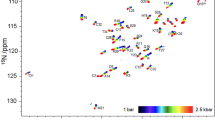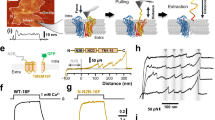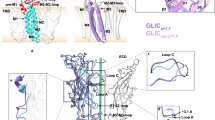Abstract
The active site of potassium (K+) channels catalyses the transport of K+ ions across the plasma membrane1—similar to the catalytic function of the active site of an enzyme—and is inhibited by toxins from scorpion venom. On the basis of the conserved structures of K+ pore regions2 and scorpion toxins3,4, detailed structures for the K+ channel–scorpion toxin binding interface have been proposed. In these models and in previous solution-state nuclear magnetic resonance (NMR) studies using detergent-solubilized membrane proteins5,6, scorpion toxins were docked to the extracellular entrance of the K+ channel pore assuming rigid, preformed binding sites7,8,9,10,11,12,13. Using high-resolution solid-state NMR spectroscopy, here we show that high-affinity binding of the scorpion toxin kaliotoxin to a chimaeric K+ channel (KcsA-Kv1.3)14,15 is associated with significant structural rearrangements in both molecules. Our approach involves a combined analysis of chemical shifts and proton–proton distances and demonstrates that solid-state NMR is a sensitive method for analysing the structure of a membrane protein–inhibitor complex. We propose that structural flexibility of the K+ channel and the toxin represents an important determinant for the high specificity of toxin–K+ channel interactions.
This is a preview of subscription content, access via your institution
Access options
Subscribe to this journal
Receive 51 print issues and online access
$199.00 per year
only $3.90 per issue
Buy this article
- Purchase on Springer Link
- Instant access to full article PDF
Prices may be subject to local taxes which are calculated during checkout




Similar content being viewed by others
References
Hille, B. Ionic Channels of Excitable Membranes (Sinauer, Sunderland, Massachusetts, 2001)
Long, S. B., Campbell, E. B. & MacKinnon, R. Crystal structure of a mammalian voltage-dependent Shaker family K+ channel. Science 309, 897–903 (2005)
Miller, C. The charybdotoxin family of K+ channel-blocking peptides. Neuron 15, 5–10 (1995)
Garcia, M. L., Gao, Y. D., McManus, O. B. & Kaczorowski, G. J. Potassium channels: from scorpion venoms to high-resolution structure. Toxicon 39, 739–748 (2001)
Takeuchi, K. et al. Structural basis of the KcsA K+ channel and agitoxin2 pore-blocking toxin interaction by using the transferred cross-saturation method. Structure 11, 1381–1392 (2003)
Yu, L. et al. Nuclear magnetic resonance structural studies of a potassium channel-charybdotoxin complex. Biochemistry 44, 15834–15841 (2005)
Mackinnon, R. & Miller, C. Mutant potassium channels with altered binding of charybdotoxin, a pore-blocking peptide inhibitor. Science 245, 1382–1385 (1989)
Hidalgo, P. & Mackinnon, R. Revealing the architecture of a K+ channel pore through mutant cycles with a peptide inhibitor. Science 268, 307–310 (1995)
Aiyar, J. et al. Topology of the pore-region of a K+ channel revealed by the NMR-derived structures of scorpion toxins. Neuron 15, 1169–1181 (1995)
Aiyar, J., Rizzi, J. P., Gutman, G. A. & Chandy, K. G. The signature sequence of voltage-gated potassium channels projects into the external vestibule. J. Biol. Chem. 271, 31013–31016 (1996)
MacKinnon, R., Cohen, S. L., Kuo, A. L., Lee, A. & Chait, B. T. Structural conservation in prokaryotic and eukaryotic potassium channels. Science 280, 106–109 (1998)
Eriksson, M. A. L. & Roux, B. Modeling the structure of Agitoxin in complex with the Shaker K+ channel: A computational approach based on experimental distance restraints extracted from thermodynamic mutant cycles. Biophys. J. 83, 2595–2609 (2002)
Yu, K. et al. Computational simulations of interactions of scorpion toxins with the voltage-gated potassium ion channel. Biophys. J. 86, 3542–3555 (2004)
Legros, C. et al. Generating a high affinity scorpion toxin receptor in KcsA- Kv1.3 chimeric potassium channels. J. Biol. Chem. 275, 16918–16924 (2000)
Legros, C. et al. Engineering-specific pharmacological binding sites for peptidyl inhibitors of potassium channels into KcsA. Biochemistry 41, 15369–15375 (2002)
Creuzet, F. et al. Determination of membrane-protein structure by rotational resonance NMR: Bacteriorhodopsin. Science 251, 783–786 (1991)
Opella, S. J. & Marassi, F. M. Structure determination of membrane proteins by NMR spectroscopy. Chem. Rev. 104, 3587–3606 (2004)
Lange, A. et al. A concept for rapid protein-structure determination by solid-state NMR spectroscopy. Angew. Chem. Int. Edn Engl. 44, 2089–2092 (2005)
Luca, S. et al. Secondary chemical shifts in immobilized peptides and proteins: A qualitative basis for structure refinement under Magic Angle Spinning. J. Biomol. NMR 20, 325–331 (2001)
Lange, A., Luca, S. & Baldus, M. Structural constraints from proton-mediated rare-spin correlation spectroscopy in rotating solids. J. Am. Chem. Soc. 124, 9704–9705 (2002)
Ranganathan, R., Lewis, J. H. & MacKinnon, R. Spatial localization of the K+ channel selectivity filter by mutant cycle-based structure analysis. Neuron 16, 131–139 (1996)
Goldstein, S. A. N., Pheasant, D. J. & Miller, C. The charybdotoxin receptor of a Shaker K+ channel: Peptide and channel residues mediating molecular recognition. Neuron 12, 1377–1388 (1994)
Zhou, Y., Morais-Cabral, J. H., Kaufman, A. & MacKinnon, R. Chemistry of ion coordination and hydration revealed by a K+ channel–Fab complex at 2.0 Å resolution. Nature 414, 43–48 (2001)
Zhou, Y. & MacKinnon, R. The occupancy of ions in the K+ selectivity filter: Charge balance and coupling of ion binding to a protein conformational change underlie high conduction rates. J. Mol. Biol. 333, 965–975 (2003)
Lenaeus, M. J., Vamvouka, M., Focia, P. J. & Gross, A. Structural basis of TEA blockade in a model potassium channel. Nature Struct. Mol. Biol. 12, 454–459 (2005)
Gouaux, E. & MacKinnon, R. Principles of selective ion transport in channels and pumps. Science 310, 1461–1465 (2005)
Park, C. S. & Miller, C. Interaction of charybdotoxin with permeant ions inside the pore of a K+ channel. Neuron 9, 307–313 (1992)
Anderson, C. S., Mackinnon, R., Smith, C. & Miller, C. Charybdotoxin block of single Ca-2+-activated K+ channels - Effects of channel gating, voltage, and ionic-strength. J. Gen. Physiol. 91, 317–333 (1988)
Gross, A., Abramson, T. & Mackinnon, R. Transfer of the scorpion toxin receptor to an insensitive potassium channel. Neuron 13, 961–966 (1994)
Acknowledgements
We are grateful to H. Kratzin and K. Overkamp for peptide analysis. Technical assistance by B. Angerstein is gratefully acknowledged. We thank C. Griesinger for continuous support of this project. This work was funded in part by the DFG and by a PhD. fellowship to A.L. from the Stiftung Stipendien-Fonds of the Verband der Chemischen Industrie. Author Contributions O.P., S.B. and M.B. are co-senior authors.
Author information
Authors and Affiliations
Corresponding author
Ethics declarations
Competing interests
Reprints and permissions information is available at npg.nature.com/reprintsandpermissions. The authors declare no competing financial interests.
Supplementary information
Supplementary Notes
This file contains Supplementary Methods, Supplementary Figures 1-3 and legends, Supplementary Tables 1–7 and Supplementary References. (PDF 2560 kb)
Rights and permissions
About this article
Cite this article
Lange, A., Giller, K., Hornig, S. et al. Toxin-induced conformational changes in a potassium channel revealed by solid-state NMR. Nature 440, 959–962 (2006). https://doi.org/10.1038/nature04649
Received:
Accepted:
Issue Date:
DOI: https://doi.org/10.1038/nature04649
This article is cited by
-
Characterizing proteins in a native bacterial environment using solid-state NMR spectroscopy
Nature Protocols (2021)
-
Solid-state NMR spectroscopy
Nature Reviews Methods Primers (2021)
-
Shifts in the selectivity filter dynamics cause modal gating in K+ channels
Nature Communications (2019)
-
Potassium channel selectivity filter dynamics revealed by single-molecule FRET
Nature Chemical Biology (2019)
-
Equilibria between the K+ binding and cation vacancy conformations of potassium channels
Protein & Cell (2019)
Comments
By submitting a comment you agree to abide by our Terms and Community Guidelines. If you find something abusive or that does not comply with our terms or guidelines please flag it as inappropriate.



